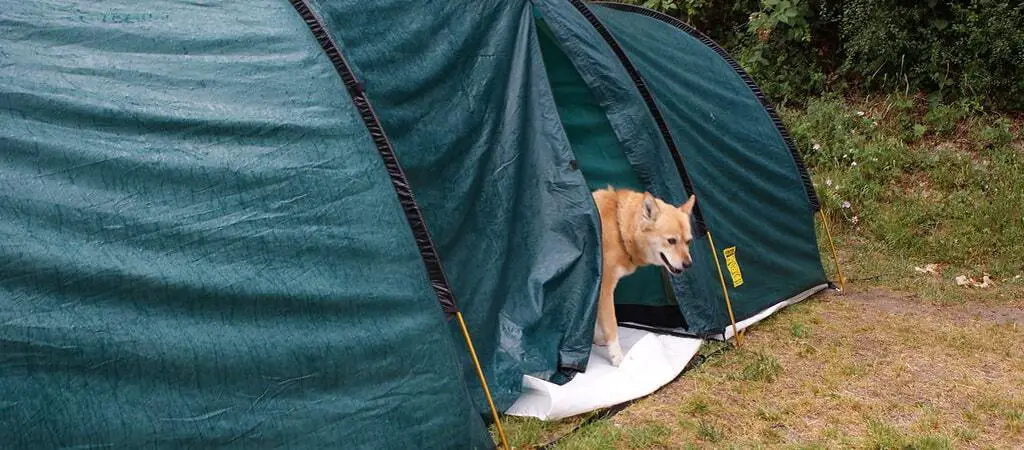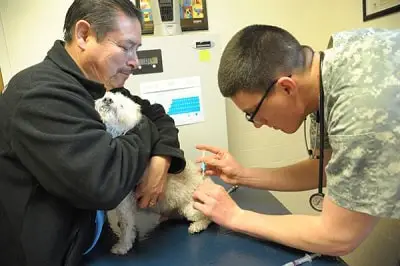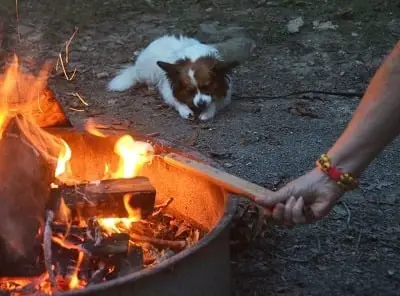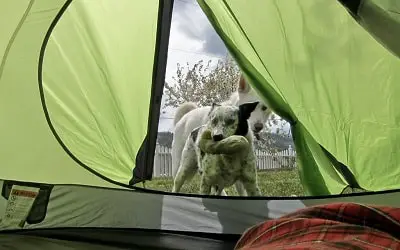Like most of you who came to this post, I own a dog; her name is Bilbi. For many years I’ve been camping around Europe and the USA, although it never occurred to me to bring my beloved pet along the way. The first time I did so was a few months ago, and the research I’ve made beforehand did teach me a few tricks to get the adventure done successfully. Let’s dive right into it and figure out how to take your dog camping.

Follow these steps to take your dog on a camping trip successfully:
- Bring a pet first aid kit in a case of injury.
- Check the campsite legislation to ensure dogs are allowed.
- Plan the sleeping arrangements according to your dog’s behavior and attitude.
- Check how your dog behaves outdoors beforehand; take him to a picnic, for instance.
- Pay a visit to your vet to get the proper vaccinations.
- Bring along enough pick-up bags to keep things clean and keep insects away.
- Detect certain behaviors which wouldn’t do good outdoors (barking, roaming, etc.)
1. Bring a Pet First Aid Kit With You
As you go camping with your furry friend, you have to consider its health and wellbeing seriously. Campsites can have a lot of activity, which can be fun for both of you. But also, for this very reason, accidents are very likely to happen.
For instance, your dog might get into a fight with another dog and get injured. It could also get stung by bees or wasps or suffer bites from other animals that roam the wild.
Dogs can also get hurt while getting past thorny bushes. Your canine friend might also get ticks from its interactions with all the other canines roaming around the campsite.
Additionally, it can also suffer allergies which would need first aid services before a veterinary officer gets a closer and more detailed look at the situation. Therefore, be sure to bring your pet first aid kit as you go camping with your dog.
Some of the things to include in your kit include a gauze roll, tweezers which you can use to remove thorns, medication to apply on wounds, bandages to cover the injuries and so forth (credit to tasteofthewildpetfood).
In other words, you have to be ready to give your dog all the assistance it needs in case it gets into a situation where it suffers from an injury or a health issue.
Certainly, there are some things which are common to both humans and dogs in a human first aid kit, but you still need a pet-specific first aid kit as some pet emergencies are pretty unique to them (according to this source).
Also, you should have with you a pet first aid book that lets you know how to handle specific emergencies such as choking. Otherwise, you can by a pet first aid kit from most pet supply stores, and you can also put together a first aid kit of your own.
2. Know The Law
Like states, different camping grounds have different rules on pets. Therefore, you can show up with your dog, excited to have a camping trip of your lifetime, but then get thrown out of the camp because it does not allow pets.
To avoid such embarrassing scenarios, you should do a little digging first to understand what rules the campsite has regarding pets or even dogs in particular.
Luckily, a little research online can help you understand what regulations say about bringing dogs to most campsites. But don’t stop your inquiry as soon as you know that a campsite allows dogs. Look into how they expect these pets to be handled by their owners.
For instance, it would be a shame to be disallowed entry into a campsite that allows dogs simply because you did not bring a leash as the regulations demand. Otherwise, you can find all the information you need from websites by national parks, the Forestry Service, and even state and county park websites.
3. Plan Your Sleeping Arrangements
It can be easy taking your dog with you as you go out. However, you have to think ahead if you are going to spend days with it at a camping site, especially with regards to its sleeping requirements.
For instance, will you let your dog loose inside the tent? You also have to ask yourself, will you keep it inside a crate, maybe outside the tent? It is vital to ensure that your dog also enjoys a comfortable sleep.
Additionally, since you will most likely be out in the woods, if you plan on letting your dog sleep outside, ensure that it will be safe from wild animals that could come to attack your dog. For instance, you can get a bear-proof cage so that your pet does not become prey to these vicious creatures of the wild.
If your camping area is likely to be accompanied by bears, I highly suggest that you read the article that I’ve written on what you should do if a black bear is outside your tent.
In there, I’ve gathered six essential tips describing how to act in this situation and concluded whether or not a tent would provide proper shelter.
4. Know Your Dog
At home, your dog might be fun and adorable, but that does not mean it will have a similar demeanor in a camp setting. In other words, you have to assess whether your dog is ready to live in a camp situation. Some dogs are naturally more active, while others are more laid back.
In the latter case, a camp with very vibrant and active outdoor activities might be exhausting for it. So, unless that dog has decent experience venturing outside, you should be cautious about taking it for a camping trip that involves such a heightened level of activity.
Also, consider how the dog interacts with strangers and even other dogs. Nobody will like it when your dog starts to get into fights with other dogs in the camp because it is not used to being around other dogs.
And even if your dog is friendly, understand that other campers might not be excited to share their meals with your overly friendly dog. In these circumstances, a leash might help keep things under control (credit to rover for that tip).
However, regardless of what your dog is like, you can still plan an exciting camping trip. For instance, if your dog prefers your company above anyone else’s, including other dogs, you merely have to be prepared to keep it close by throughout your entire trip.
But if you are not sure how your dog will behave once you get to the camp, you can always take your dog on a picnic in a camp-like setting and see how things go.
If it adapts well to the camp life and seems to get along well with everyone at the camp, then you can have the assurance you will not have much to worry about when you take it for an extended camping adventure.
5. See a Vet
Your dog should be in perfect health before going into any camp. Since a campsite has many things going on that might be beyond your control, as far as the health of your dog goes, it is essential to be ready for any health emergencies.
For instance, it should be vaccinated comprehensively beforehand so that it does not catch any illnesses during your camping trip. A medical checkup can also help reveal any illnesses that might be in their initial stages so that they can be addressed in time.

This can keep your dog from infecting other pets at the camp or experiencing a dire medical condition when you are far off the grid without easy access to a vet. In addition to this, you should have medications to treat common emergencies if they do occur.
For instance, you can have treatments for heartworms, ticks, fleas, and so forth. However, you can also take preventive medications for these conditions. As you go for this medical checkup, be sure to use an AAHA-accredited animal hospital (according to this source).
If the dog has a microchip or a tag, ensure that it has your cell phone number in case someone else needs to contact you if it gets into any situations that demand your assistance.
6. Carry Pick-Up Bags
These days, many people go camping with their dogs. But dogs leave around their waste as you move along, and it’s easy to ignore it and move along. That is not proper etiquette, as a lot of dog waste at campsites and even parks can pile up and become an environmental problem.
The woods would suffer if too much dog waste were left lying around. Besides, they would not be as fun and adventurous for you if all dog owners who went into them did not pick up after their pets.
Therefore, bring a pick-up bag with you whenever you go into the woods to ensure that your dog does not leave a trace (credit to rei). Do not rely on the campsite to provide with these.
That waste can contaminate the water and the soil, and even promote infections and the spread of germs that can put the health of your dog and even your own at risk when all you are trying to do is have a good time. In short, get yourself pick-up bags in your kit as you enjoy camping time with your dog.
7. Find Out if Your Dog Belongs in a Camp
Trying to understand how your dog will behave when you get to a campsite is one thing, and learning how to deal with certain behaviors is another. For instance, some dogs bark a lot, while others cannot stay put and will wander from one place to another.
How do you deal with such problems? Because, obviously, they can become an issue for other campers and even for you? In general, if your dog barks a lot, then you might consider letting it stay at home or cutting your camping trip short.
If it cries throughout the night, you might wake up to a horde of very angry campers willing to harm you and your dog, and there is no way you can have any fun under such circumstances.
Basically, if your dog barks too much and you want it to join you on your trip, then have the behavior trained out of it beforehand because night long yelling is never going to work out with other campers.
Another issue you should be concerned about is if your dog wanders too much. In this case, having a leash can help, even at night, to avoid having to search for it every morning throughout the camp.
Such a dog can also be a little naughty, helping itself to foods near campfires, and that can get you into heated exchanges with campers who don’t appreciate such behaviors.
How Can I Keep my Dog Safe While Camping?
Be Aware of The Campfire
Dogs have a natural recoil from fire, although in some cases it may be dangerous. If your dog is irritated or intimidated by some wild animals, it might get out of control and even run towards flames.
If you are building a campfire, make sure that you tie your dog leash to a tree far away from the area. Also, make sure to avoid acorns, which may pop-up and scare your beloved pet.

Make sure that you build your fire with the proper stones so that they do not crack and make scary noises. I’ve been discussing that phenomenon previously on an article I’ve written on how to avoid exploding campfire rocks.
In there, I’ve gathered all the wrong kinds of stones you might use and added my perspective on which rocks you should circle your fire with. Also, try to build your fire clean.
I highly recommend that you read another article by me in which I answered why do bonfires smoke so much and provided with a few ways to reduce the smoke. Too much of it may irritate your dog and attract animals with a strong sense of smell.
Know The Weather Upfront
It is crucial that you check the weather upfront before going on your camping adventure with your dog. The most dangerous phenomenon would probably be a thunderstorm, in which your pet might get frightened and even flee away to the wild.
On a different article I’ve written, I have listed 15 tips on how to camp in a lightning storm. I highly suggest that you take a look at this; it both covers what to do if one catches you, and teaches you some great techniques on how to check the weather beforehand.
Also, make sure that the weather isn’t too hot, so your dog doesn’t get dehydrated. Remember, dogs can’t sweat light humans, and their body temperature elevates much more quickly.
Keep Away From Wild Animals And Insects
My first advice to you on that topic would be keeping your campsite clean. When you leave food residues outside, bears, snakes, and insects tend to pay a visit to your campsite.
Also, do not use too many deodorants and perfumes; from my experience, body cultivation products tend to feature strong odor which attracts wild animals.
Also, try to pick an area which isn’t riched with wild animals. I suggest that you google the place upfront or even call the information center to know better. Make sure not to walk your dog in dense forests or near bushes; stick to open places instead.
Can a Dog Sleep in a Tent?
Yes, dogs may comfortably sleep aside you in your tent, although there are a few things to consider. Make sure that your shelter is well ventilated since dogs’ breath tends to be humid and condensation would rapidly build inside otherwise.
Keep your tent’s door a bit zipped open so that air could naturally circulate inside. Another thing worth considering is sleeping in a floorless shelter. The exposed ground is much more friendly to dogs, and you won’t be risking any tears by its palms.

It would be easy to build a shelter by yourself by hanging a tarp from above in a pyramid shape. To do so, I highly suggest that you take a look at an article I’ve written regarding 15 essential camping knots which are used worldwide.
In there, I’ve included a few videos so you get a proper visual view on how to make these knots which would hold your tarp steady. It is okay if your shelter doesn’t feature any walls.
There is a good chance your dog will roam a little during the night, although eventually, it would come back to sleep next to you, so do not worry too much about it.
Which Vaccines Should my Dog Get Before Camping?
It is crucial that you pay a visit to your vet before you take your dog camping. According to this source, your dog might catch Distemper, Hepatitis, Parainfluenza, and Parvovirus quite quickly when you are spending some time outdoors.
The DHPP series of vaccinations could cover all of these. A few more series of injections would also include Bordetella, Rabies, and Leptospirosis.
Your veterinarian would probably know which ones are essential to your dog according to your destination. Do not take any chances; if your dog is dear to you, make the necessary effort to protect it up front.
Conclusions
You shouldn’t hesitate to take your dog with you on camping, although it is essential that you consider the points listed above to get the most of it. Make sure you are certain your dog could behave appropriately outdoors and can stay put quietly.
Also, pay attention to the necessary vaccinations beforehand and take along a pet first aid kit in a case things go wrong. Regarding sleeping arrangements, your dog could sleep inside your tent next to you; there is nothing wrong with it. Nevertheless, make sure you keep things ventilated and favor a floorless shelter.
I hope my article had answered your question on how to take your dog camping. If you have any new insights of your own, let me know all about them by leaving a comment below!

